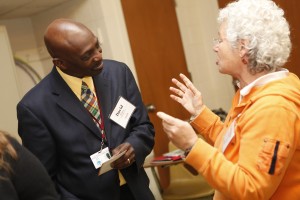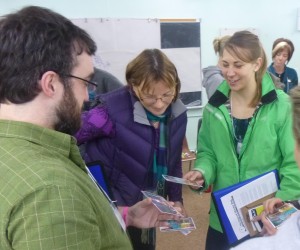Oct 06, 2016 Beware of the Icebreaker
Excerpt from Tips & Tools for the Art of Experiential Group Facilitation Second Edition
In chapter one of Tips & Tools and previous Inspired Educator Blog Posts, I’ve emphasized how important it is to carefully assess your group, and be aware of putting individuals in the spotlight too early in the group process. Putting learners on the spot before they have developed trust and rapport with the group can inhibit learning. Conversely, when time is taken early on to build a sense of comfort and control and ownership within the group, it leads to increased engagement and meaningful interaction throughout the group process.
 An icebreaker is meant to break the ice— and to build a foundation of respect, trust, and a willingness to share essential to a productive and supportive learning community. Often icebreakers do the opposite of what was intended, placing individuals in awkward situations too early in the group process. Many people have negative connotations with team-building and ice-breakers because they have been put in situations where choice and control were taken away. They were put on the spot too early, embarrassed, asked to share intimate information, act silly, or perform in front of a group before they were comfortable doing so. There is a reason satirical comedy shows like The Office (Carell, Kaling, & Novak, NBC, 2005-2013) have dedicated whole episodesto the down side of team-building, and teenage movies such as Mean Girls (Waters & Fey, 2004) include a school or camp group-builder gone bad.
An icebreaker is meant to break the ice— and to build a foundation of respect, trust, and a willingness to share essential to a productive and supportive learning community. Often icebreakers do the opposite of what was intended, placing individuals in awkward situations too early in the group process. Many people have negative connotations with team-building and ice-breakers because they have been put in situations where choice and control were taken away. They were put on the spot too early, embarrassed, asked to share intimate information, act silly, or perform in front of a group before they were comfortable doing so. There is a reason satirical comedy shows like The Office (Carell, Kaling, & Novak, NBC, 2005-2013) have dedicated whole episodesto the down side of team-building, and teenage movies such as Mean Girls (Waters & Fey, 2004) include a school or camp group-builder gone bad.
 People do learn from challenges; however, there is a fine line between a challenge that helps move learning forward and what the educational philosopher John Dewey (1938) called a “miseducative” or potentially damaging experience.* There are still educators who believe that stress increases people’s ability to learn and be creative. There are icebreakers, games, and initiatives used in group work that were designed to quickly push people out of their comfort zones in order to initiate learning. Though we learn from novelty and from being challenged, brain research shows us that it needs to be the right amount of challenge at the right time (Willis, 2013). Be aware that any experience designed to push people out of their comfort zone has the potential for the amygdalae (located in the temporal lobes of the brain) to take over and push learners into “fight or flight mode,” resulting in checking out or acting out.
People do learn from challenges; however, there is a fine line between a challenge that helps move learning forward and what the educational philosopher John Dewey (1938) called a “miseducative” or potentially damaging experience.* There are still educators who believe that stress increases people’s ability to learn and be creative. There are icebreakers, games, and initiatives used in group work that were designed to quickly push people out of their comfort zones in order to initiate learning. Though we learn from novelty and from being challenged, brain research shows us that it needs to be the right amount of challenge at the right time (Willis, 2013). Be aware that any experience designed to push people out of their comfort zone has the potential for the amygdalae (located in the temporal lobes of the brain) to take over and push learners into “fight or flight mode,” resulting in checking out or acting out.
There are many ways to both break the ice and avoid these pitfalls. One is to begin with partner-sharing activities described earlier in this chapter rather than large group introductions. This gives participants an opportunity to warm up by interacting with just one or two others before being asked to share with the larger group. Simple but intentional things done by the facilitator from the beginning of a program can cultivate an atmosphere where learners are given a sense of choice and control. Weaving opportunities for choice into activities sets a positive, trusting tone. (See more about choice and control in chapter 4.) See my next post for rapport-building activities and techniques to help participants experience what John Dewey (1916, 1938) called “perceived internal freedom” and buy into the group process.
* John Dewey(1938) used the terms “miseducative” and “uneducative” to refer to types of experiences that do not promote education. An experience is miseducative if it limits or interferes with a person’s future growth. For example, when participants find a challenge course experience overwhelming or too frustrating, they might dismiss it entirely.
References:
Dewey, John. (1938) Experience and Education. New York: Macmillan Publishing Co.
Dewey, J. (1916) Democracy and Education. An introduction to the philosophy of education (1966 edn.), New York: Free Press
Stanchfield, Jennifer (2016) Tips & Tools for the Art of Experiential Group Facilitation Second Edition. Bethany, OK: Wood N Barnes Publishing.
Willis, J. (2010). Understanding and Planning Achievable Challenge. Learning to love math teaching strategies that change student attitudes and get results (pp. 16-32). Alexandria, Va.: ASCD.
Willis, J. (2012, November 16). Neuroscience of the Adolescent Brain Reveals Challenges and Opportunities for Positive Interventions. Learning & the Brain Conference: Educating Diverse Minds. Lecture conducted for The Learning & the Brain Society/Public Information Resources, Boston, MA.



No Comments